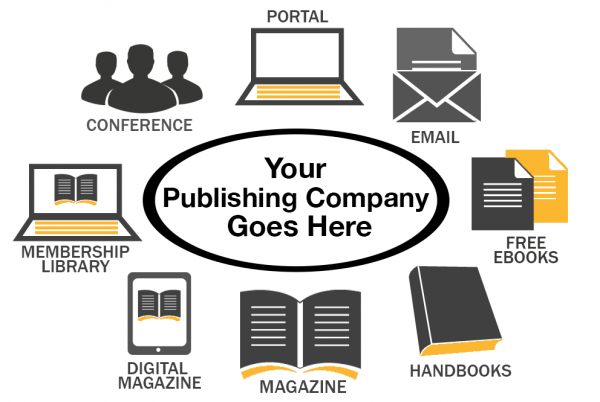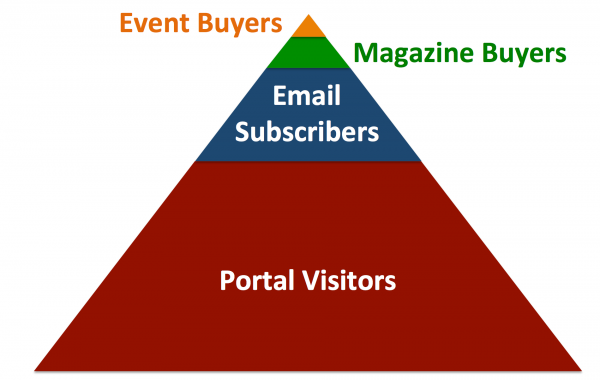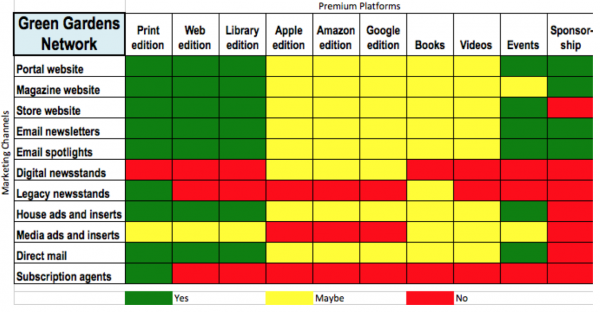Mequoda Multiplatform Publishers build profitable Mequoda Pyramids with a Mequoda Matrix as their guide and a Mequoda Portal as their foundation…
Over the past several weeks, we’ve rolled out a foundation of what we consider the most essential building blocks of a multiplatform publishing system. We believe that by using these building blocks, any publisher can begin to build a profitable multiplatform publishing empire.
1. What is a Mequoda Multiplatform Publisher?
Some of the most successful publishers we know publish on many different platforms. When we present these case studies at our events, we create brandwheels, a concept borrowed from Time Inc. when we worked with Real Simple several years ago.

The most important thing you need to know about multiplatform publishing, and how Mequoda sees a good, effective and profitable brandwheel, is that the content is recycled across the many different platforms. For example, blog posts are recycled into reports, videos are turned into blog posts, and magazine articles are recycled into a premium library, or handbooks, or cut down into many small blog posts. What does your multiplatform publishing brandwheel look like? Read more about how to become a multiplatform publisher.
[text_ad]
2. What is a Mequoda Multiplatform Pyramid?
When you hear the word “pyramid” in the world of business, your thoughts may go in a different direction but at Mequoda, we’ve found a pyramid to be the best way to show how any publishing business makes money.
Publishers implementing a vertically integrated strategy use outside media to acquire new customers, leveraging “free media” first. This free media comes from your Portal, which is why we call them Portal visitors. These publishers then use content to build a permission database of portal visitors and turn them into email subscirbers. They convert those email subscribers into buyers when they create products like magazines, books and other products, then recycle, reuse, and republish content. Finally, they are able to pull customers up the pyramid to maximize profit to their highest-priced product.

Why have we chosen the pyramid as a graphic symbol? Like an upside-down funnel, you have your largest audience at the bottom, typically your non-paid users, and as you grow toward the top, you can see how your users eventually convert into paid users for products at higher price points. Each succeeding audience is a smaller group accessing the platform, while their investment of time and money goes up. Read more about the Mequoda Multiplatform pyramid.
3. What is a Mequoda Portal?
Portals are intended to build and feed an audience; they are specifically designed for SEO, email marketing, list building, and lead generation.
Portal subscription websites generate value from both the users and the sponsors. Users pay—not with money (all website content is free) but with time and information. They spend time viewing web pages, emails and RSS feeds, thus creating advertising inventory that can be used to sell the publisher’s products (internal advertising) and/or sold to third party sponsors (external advertising) on a CPM (cost per thousand), CPC (cost per click) or CPA (cost per action) basis.
The most well-known of the portal subscription websites is Yahoo.com– but it’s actually more than just a portal. Yahoo is actually a huge collection of dozens of different kinds of websites, making it what we call a media website, online business or website network. But many Yahoo sites are indeed portals, and Yahoo itself is widely known as a portal.
It’s a Mequoda best practice to build a portal for every subscription website we create. Read more about Mequoda Portals and see examples.
4. What is a Mequoda Multiplatform Media Matrix?
When we work with magazine publishers – both legacy and digital natives, we create a business plan that includes a chart we call the Mequoda Multiplatform Media Matrix. We do this in order to identify what opportunities exist for their brand, and also which platforms should be prioritized.
Across the top, you’ll see various kinds of premium platforms. Down the left side are the different marketing channels. The Mequoda Multiplatform Media Matrix is all one big way of figuring out where your opportunities exist. Learn more about the multiplatform media matrix.

Are you building out your multiplatform publishing business? These are the foundational building blocks of any multiplatform publishing system, although you’ll discover many additional strategies in our Multiplatform Publishing Handbook.


